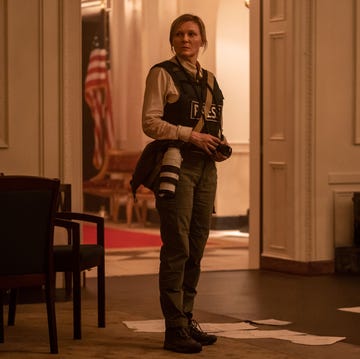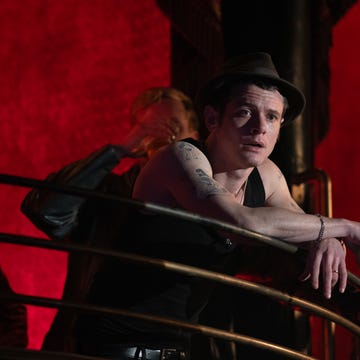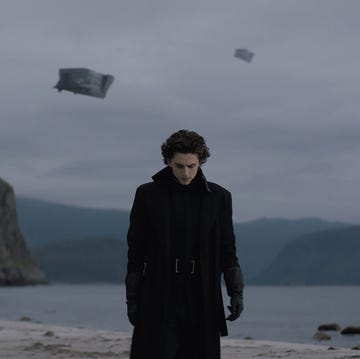A documentary's main job is to tell the truth. But here's the problem: sometimes the truth hurts (or offends), which can lead to the film becoming banned.
Here are seven documentaries that you'll probably never be able to watch. And the shadowy reasons why…
1. The Sweatbox (2002)
When Sting was hired to write the songs for The Emperor's New Groove (then called Kingdom Of The Sun), part of his deal stipulated that his documentarian wife, Trudi Styler, be allowed to shoot a making-of film about the process.
If Disney were expecting a typical EPK fluff-doc, they didn't get it. The subsequent feature-length documentary, named 'The Sweatbox' was a warts-and-all film that told the truth about what it was like to work for Disney in the '90s – and the truth was, it wasn't pleasant. The Sweatbox was so upfront and honest, it even included the moment Sting was told his songs were being removed from the main film.
According to Wade Sampson, one of the few reviewers able to see the full film before it was pulled, "Rarely have artists been caught so evocatively in fear of executives, or executives portrayed as so clueless as to how to deal with artists, how to resolve story problems and how to understand what audiences wanted."
Disney have the rights to The Sweatbox and are, unsurprisingly, not too keen to release it. A heavily edited down version 'Making the Music Video' appears as a featurette on The Emperor's New Groove DVD.
2. Let It Be (1970)
Another case of a documentary that got a little too close to the truth, Let It Be should have provided fans with time-capsule insight into the making of their favourite band's ninth studio album.
Instead, the filming added pressure to a situation that was already pretty tense, arguably contributing to The Beatles' break-up. The rough cut was screened to the band in July 1969, and in September 1969, John Lennon told the band he was leaving the group. (The Beatles announced their split in 1970.)
A version of the documentary was made available to cinema audiences, but has never seen a home release. Even then, it was a cut-down version with an hour shorn from the runtime.
An insider revealed what we'll never get to see: "There was much more stuff of John and Yoko, and the other three didn't really think that was appropriate because they wanted to make it a 'nicer' movie. They didn't want to have a lot of the dirty laundry, so a lot of it was cut down."
After watching the edited version, Lennon said he felt that 'the camera work was set up to show Paul and not to show anybody else' and that 'the people that cut it, cut it as 'Paul is God' and we're just lyin' around...' Oof.
3. Save The Children (1969)
In 1969, Ken Loach was hired by Save The Children to make a documentary about the charity.
They probably assumed that the social-realist director of Cathy Come Home would be sympathetic to their cause. The only problem was, Loach really, really wasn't.
Splitting the film into two halves – half in the UK, half in Kenya – Loach laid bare the hypocrisy and colonial attitudes he saw at the heart of the charity in the late '60s.
Unsurprisingly, Save The Children stopped the film from being released, but a court ruling stipulated that the film be preserved in the BFI Archives, with access restricted unless the charity gave permission for it to be viewed.
In 2011, 42 years after it was created, the charity permitted a one-off public screening at the BFI to mark Loach's 75th birthday. Still, you're more likely to see Kes 2 than a Blu-ray release of this one.
4. Sikkim (1971)
Satyajit Ray is arguably India's greatest director – his films are celebrated and archived across the world. But there's one of his films you'll never get to see, thanks to a fairly complex political situation.
Ray was commissioned by the King of Sikkim to make a documentary celebrating the sovereignty of the country. Ray complied and made a film that's almost certainly as poetically powerful as every other film he ever made. According to Ray, "The end is very lively, very optimistic, with children, happy, laughing, smoking, singing. The whole thing builds up into a paean of praise for the place." (Wait – "children happy… smoking?")
But then Sikkim (the place) became an Indian state and Sikkim (the film) was double-banned, by the film's commissioners and the Indian government. Which is a shame, as it sounds quite nice. "Sikkim is beautiful, more an essay from a respected travel journal from Ray's era accompanied by detailed photographs that graced magazines like Life," a New Statesman review said when the film was screened for the first and only time in 2010, 39 years after its creation, at the 16th Kolkata Film Festival. The film was pulled after that solitary screening, and remains banned.
5. Bare Fist: The Sport That Wouldn't Die (1997)
Bare Fist has been turned down for a BBFC certificate twice, both times because the board were worried that the documentary glamourised the sport of bareknuckle boxing, with the bonus possible issue that it provides potentially lethal advice on how to win fights (such as lacing bandaged fists with fragments of glass).
While we're sure no-one would actually make a film that tells people how to kill people doing the thing they want to celebrate, the risk was too great for the board, and Fight Club fans will have to get their thrills elsewhere (such as, you know, Fight Club).
6. Brave, Bashed, Battered and Bruised (1997)
What was going on in 1997? Essentially one long montage of people getting brutally hurt during martial arts fights, concluding with one man attempting to survive a 40-to-one bare knuckle brawl, this documentary was rejected by the BBFC because they saw the film as 'selling the pleasures of gross violence through its unrelenting focus on the infliction of injury and pain.' Yeesh.
Instead of showing you anything from this film, we've linked to a montage from the Karate Kid instead, because we're nice.
7. Traces of Death (1993)
Brace yourself, this one's gross. Traces Of Death compiles footage of real images of death and suffering, with limited contextual framing outside of "Woah, cool!" – which meant it was considered to have "no journalistic, educational or other justifying context" by the BBFC, making it liable to deprave and corrupt its audience (thus contravening the Obscene Publications Act).
It's available in the US, but with the UK's stricter certification policy when it comes to violent images, it's safe to say this one won't be popping up in your local Tesco any time soon.
Freelancer writer
Sam is an entertainment writer with NCTJ accreditation and a twenty-year career as a film journalist.
Starting out as a staff writer at Total Film, moving up to Deputy Online Editor, Sam was responsible for Total Film’s YouTube channel, where he revolutionised the magazine’s approach to video junkets, creating influential formats that spread to other outlets.
He’s interviewed a wide range of film icons, including directors such as David Lynch, Quentin Tarantino, Paul Thomas Anderson, Sofia Coppola, Ridley Scott, Michael Bay and Sam Raimi, as well as actors such as Meryl Streep, Nic Cage, Brad Pitt, George Clooney, Anne Hathaway, Margot Robbie, Natalie Portman, Kermit the Frog, all of the Avengers and many more.
Sam has also interviewed several comic creators, including Stan Lee, Alan Moore, Grant Morrison, and he has a zombie cameo in The Walking Dead comic.
In 2014, Sam went freelance, working directly for film studios including Warner Brothers, 20th Century Fox and Disney, as well as covering red carpet events for film marketing company PMA Productions.
Sam is the co-host, producer and editor of the Arrow Video podcast, which has seen year-on-year growth since its creation in 2017, gaining over half a million listens in that time.
His byline has appeared in outlets such as Yahoo, MTV, Dazed, Esquire, Harper’s Bazaar, Cosmopolitan, Elle, and Good Housekeeping among others.
In 2012, Sam made it to the final of the Leicester Square Theatre New Comedian of the Year competition, and went on to become a filmmaker himself, directing three features that have all played major festivals, and secured distribution – starring in two of them.
Jim Carrey once mistook Sam for Johnny Cash, and John Carpenter told him to ‘Keep up the good work.’ He promises to try his best.














